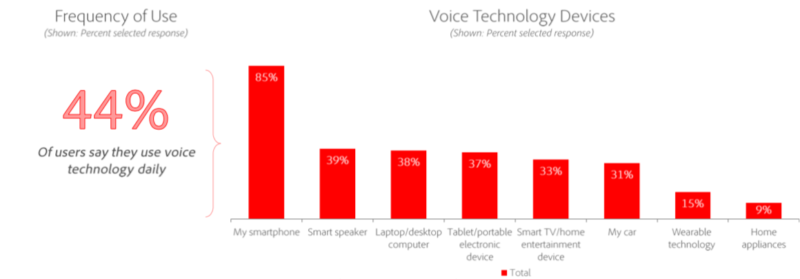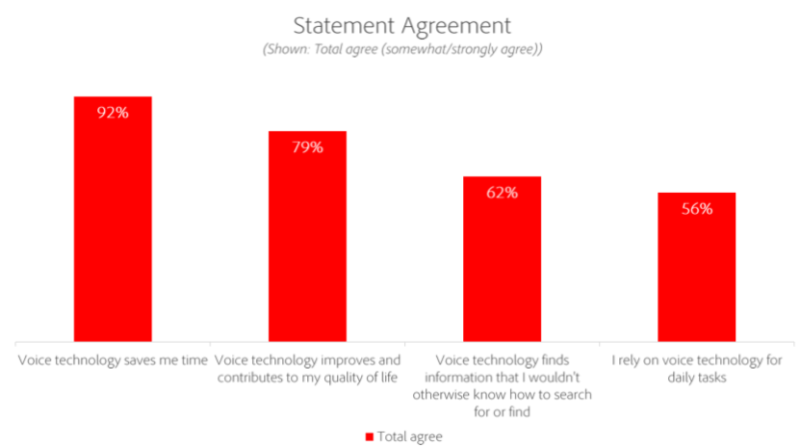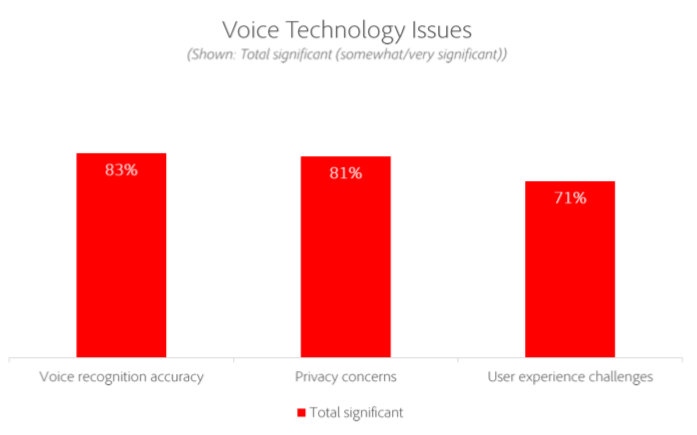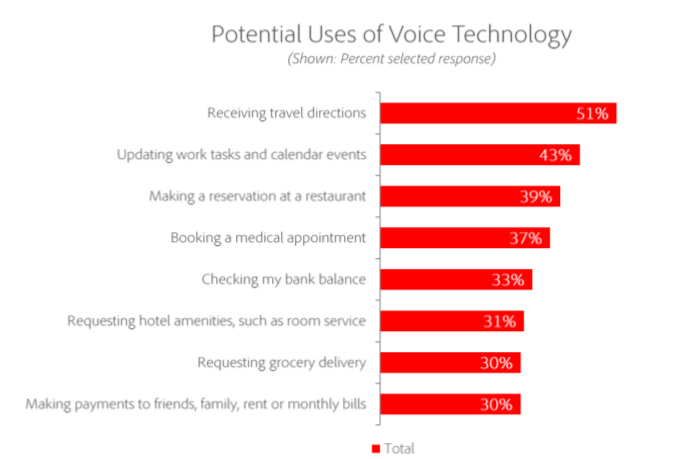The now-debunked prediction that 50% of all searches will be conducted by voice in 2020 still occasionally appears in presentations and articles. However a new voice technology survey from Adobe finds that 48% of consumers are using voice for “general web searches.” This is not the same as “50% of all searches,” but it indicates growing penetration for voice as a search interface.
Majority of activity on smartphones. Adobe’s survey of roughly 1,000 U.S. adults, like many voice-related surveys, doesn’t carefully distinguish between smartphone and smart speaker use cases. However it does make clear that most of the activities identified in the study are happening on smartphones: 85% of respondents said they had used voice technology on their smartphones, while 39% said so for smart speakers.
In terms of usage frequency, 44% of respondents said they use voice technology in some form daily.

Improving my quality of life. Satisfaction with voice technology and voice assistants was high in the survey. A striking 79% of consumers agreed with the statement, “voice technology improves and contributes to my quality of life.” That’s a pretty strong statement. And 92% agreed that “voice technology saves me time.”
That satisfaction was tempered by complaints about accuracy and comprehension. Respondents said that voice recognition technology accurately responds to a question or command only 69% of the time. This is a perception from survey respondents rather than a systematic test of objective accuracy. Indeed, accuracy and/or lack of comprehension were the top complaints among users.

Complaints about accuracy and privacy. Beyond accuracy, privacy concerns and the more vague “user experience challenges” were the top “issues” that consumers identified as significant. The question associated with the graphic immediately below was, “how significant of an issue do you think each is?”
Eighty three percent (83%) said accuracy and 81% mentioned privacy concerns. Supporting this idea, a recent survey from NPR found that privacy was a concern among smart speaker owners and non-owners and may be affecting smart speaker adoption.

One of the more interesting areas of the survey focused on desired functionality and future use cases. Before getting into that, the following were the top current uses of voice (mostly on smartphones):
- Directions while driving — 52%
- Making a phone call — 51%
- Sending a text — 50%
- Checking the weather — 49%
- Playing music — 49%
- General web searches — 48%
- Setting alarms — 41%
- Checking the news — 27%
- Sending email — 17%
- Shopping — 16%
Split decision on adopting more ‘human-like’ attributes. In terms of the future, more than 90% (94%) wanted to see voice on more devices and 44% wanted a touch screen integrated into voice activated devices (i.e., smart speakers), while 37% said they wanted virtual assistants to have a more human-sounding voice.
Asked separately about whether to incorporate more human qualities (e.g., sympathy, humor) into virtual assistants, a bare majority indicated they were in favor while 49% said voice technology didn’t need “more human-like attributes.”

The graphic above shows preferences for future “potential uses” of voice technology, several of which are already available. But the larger idea here is consumer openness to transactions through smart speakers and other voice-controlled devices. Indeed, transactions rather than ads may be the better business model in the context of virtual assistant or “voice-first” experiences.
Why we should care. The survey presents a mostly upbeat picture of the state of voice, with consumers expressing strong satisfaction, tempered with some concerns about privacy and accuracy. Consumers also appear open to a broader and more complex range of future uses of voice, offering specific recommendations for new features. Some of those are hybrid experiences that combine voice and touch to tackle more complex tasks.
This is all good news for the industry and the future of virtual assistants. But as with many new technologies, it’s taking longer than expected to figure out the user experience and the right business model — especially for smart speakers.
